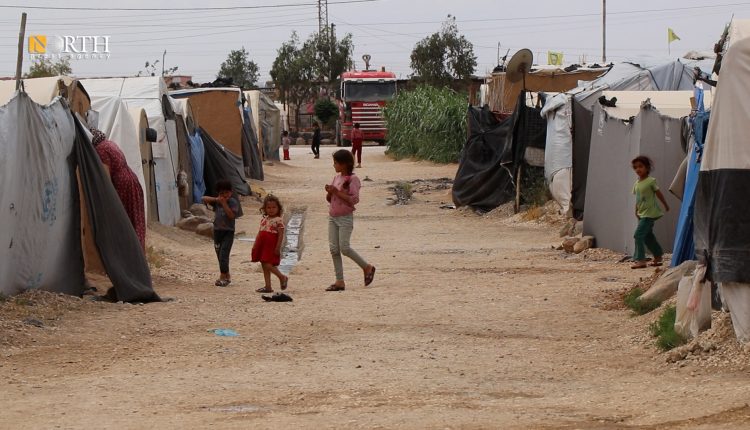
By Samer Yasin
HASAKAH, Syria (North Press) – As temperatures soar across northeastern Syria, residents of Washokani camp near Hassakah endure a brutal summer marked by suffocating heat, worsening health conditions, and crumbling infrastructure. For many of the nearly 17,000 internally displaced people (IDPs) who have lived in the camp since fleeing Turkish military operations in 2019, this year’s summer threatens to be among the most dangerous yet.
Among them is Fatoum Ibrahim, a displaced Syrian woman from the village of Dashisha near Tal Tamr. Sitting inside a sun-baked tent made of worn nylon, she recounts how last summer’s extreme heat permanently blinded her in one eye. The other eye, partially restored through an expensive surgery years ago, is all she has left. “The heat is unbearable. I can barely use the fan due to frequent power cuts, and the children here get sick all the time,” she tells North Press.
Fragile Shelter, Failing Infrastructure
Washokani camp was established by the Autonomous Administration in late October 2019 to shelter thousands of civilians fleeing Sere Kaniye (Ras al-Ain) after it fell under Turkish control. The camp currently houses 16,876 individuals across 2,377 families, most of whom live in deteriorating nylon tents that offer little protection from the harsh summer climate.
With the mercury rising and power outages frequent, even basic cooling devices like fans are nearly useless. “We pay 37,000 Syrian pounds monthly for electricity, but it’s barely enough to run a fan,” Ibrahim explains. Water, stored in large plastic tanks scattered around the camp, is undrinkably warm and rarely cooled, as electric refrigerators and water coolers remain off for most of the day due to the electricity crisis.
Children, in particular, are suffering. “They are more vulnerable to the heat because we don’t have cooling systems, and the tents act like ovens,” Ibrahim says.
Heat-Induced Illnesses and Medical Emergencies
Ahmed al-Eidan, another displaced resident originally from the village of Manajir, describes a frightening incident involving his young son. “He had a severe heatstroke that led to convulsions,” he recalls. With no air conditioning or cold water available, the family poured cold water over the child’s body before rushing him to the clinic. “We have a fan and a broken air conditioner, but without power, they’re useless. We end up buying ice blocks just to survive the heat.”
Al-Eidan, like many others, criticizes the deteriorating state of tents that have aged poorly under constant exposure to sun and rain. “The tents are falling apart. They’ve become as fragile as rusted iron,” says Sheikha Makhlaf, a displaced woman from the village of Tawila. She notes that electricity is almost entirely absent, rendering fridges, fans, and even food preservation impossible.
“The heat is breaking us,” Makhlaf says. “Our food spoils, we have no cold water to drink, and even bread doesn’t last. The children get sick constantly—diarrhea, sore throats, skin rashes.”
A Surge in Disease
The health impact of these harsh living conditions is substantial. Amad Ahmo, head of health services for the Kurdish Red Crescent in Washokani, warns of an annual spike in disease cases during summer. “Last year, we recorded over 2,000 cases of scabies and a similar number of diarrhea cases. There were also isolated cases of leishmaniasis and two confirmed cholera infections,” she says.
Children, pregnant women, and the elderly are particularly vulnerable. “The lack of cool water, the presence of flies and garbage, and overcrowded tents—often sheltering more than ten people—all create a breeding ground for illness,” Ahmo explains.
The water delivered to the camp is disinfected, but Ahmo notes that the chemicals used can sometimes exacerbate gastrointestinal issues, especially in young children.
Humanitarian Withdrawal Leaves a Void
While the Kurdish Red Crescent continues to provide essential medical care, the overall health support in the camp has been significantly weakened since the World Health Organization (WHO) ended its operations in Washokani in April 2024. Until then, the WHO had supported critical cases and provided supplementary aid to medical teams.
“The WHO’s departure was a severe blow,” says Ahmo. “Even though their assistance wasn’t sufficient compared to needs in places like al-Hol camp, they did help in performing urgent surgeries and covering expensive treatments that displaced families couldn’t afford.”
Since then, most of the medical burden has fallen on the Kurdish Red Crescent and a handful of local NGOs. The reduced presence of international actors has further limited access to medicine, diagnostics, and emergency referrals.
A Call for Action
As the summer intensifies, humanitarian needs in Washokani are growing more urgent. Families live in disintegrating tents, plagued by illness and dependent on sporadic electricity and inadequate water supplies. Community members warn that unless immediate action is taken to improve infrastructure, expand health services, and restore international support, the situation will only worsen.
Residents are not only demanding more humanitarian aid but also structural improvements: new tents, consistent electricity, proper sanitation, and long-term solutions to provide clean, cool water. “We are not asking for luxuries,” Ibrahim emphasizes. “We just want to survive the summer with dignity and health.”
In a region where conflict, displacement, and climate challenges intersect, the story of Washokani camp reflects the broader crisis facing hundreds of thousands of Syrians who have been displaced from their homes—and who remain forgotten in sweltering camps with few resources and even fewer prospects.
